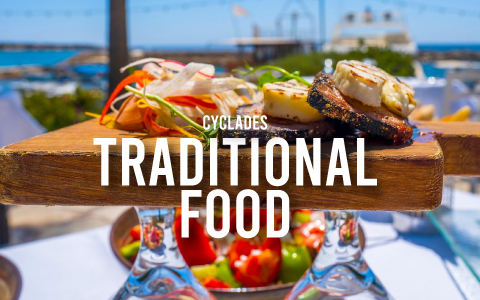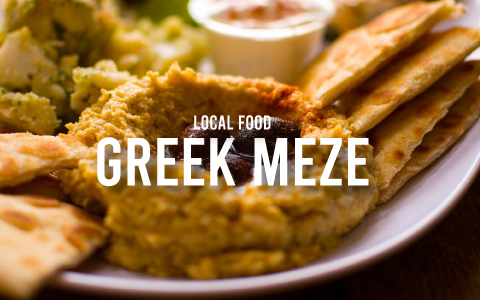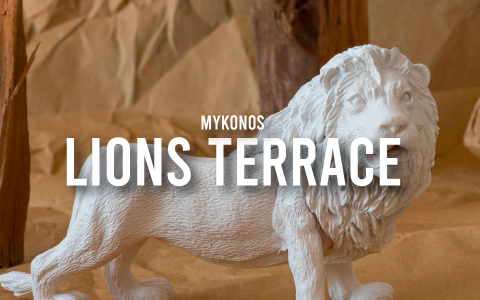
Traditional Food of the Cyclades. What to Eat in Mykonos, Paros, and Santorini
The Cyclades are a stunning constellation of Greek islands, each with its own character yet bound by a shared culture. Famous for their whitewashed houses, azure-domed churches, and breathtaking landscapes, Mykonos, Paros, and Santorini have also become a haven for food lovers seeking authentic Greek flavors.
Traditional Food of the Cyclades
Mykonos, known for its gorgeous beaches and vibrant nightlife, also treasures deeply rooted culinary traditions. Paros, with its serene fishing villages and laid-back vibe, embraces simplicity in both lifestyle and food, letting natural flavors shine. Santorini, sculpted by volcanic activity, boasts fertile soil that gives life to unique agricultural products, making its cuisine as dramatic as its famous sunset views.
So, what should you eat once you arrive in one of these islands? Here are what we consider the must-try dishes and local specialties that define the gastronomic soul of the Cyclades.
Kopanisti (Mykonos)
A cornerstone of Mykonian gastronomy, kopanisti is a spicy, creamy cheese made from cow’s or goat’s milk.
Often called the “Greek Roquefort,” it owes its sharp, peppery flavor to the fermentation process. Locals enjoy it as a meze, spread generously on bread or rusks and drizzled with olive oil. Pair it with a glass of ouzo, and you’ll experience a quintessential taste of Mykonos beyond the typical restaurant menus.
Kopanisti is often made in small family-run dairies that have passed down recipes through generations.
Louza (Mykonos)
Another treasure from Mykonos is louza, a cured pork delicacy similar to Italian prosciutto.
Traditionally, pork is seasoned with local herbs such as oregano, thyme, and savory, then air-dried in the island’s strong winds for several weeks. The result is a thinly sliced, aromatic meat with a delicate balance of salt and spice. Louza is usually served with local cheeses, olives, and fresh bread, making it an excellent meze to enjoy in a seaside taverna after a day exploring the island.
Melopita (Mykonos)
For those with a sweet tooth, Mykonos offers melopita, a pie made with soft cheese (typically tirovolia), eggs, and plenty of local honey.
Baked in phyllo pastry or as a crustless pie, melopita is fragrant, light, and irresistibly sweet. It reflects the Cycladic love for honey, which has been harvested on the islands since ancient times. A slice of melopita with Greek coffee is the perfect way to end a traditional Mykonian meal.
Gouna (Paros)
If Paros has a signature dish, it’s undoubtedly gouna. This unique preparation involves sun-drying mackerel before grilling it to perfection. The sun preserves and intensifies the fish’s flavor, while grilling brings out a smoky richness.
Gouna is seasoned simply with oregano and lemon, reflecting the island’s philosophy of highlighting natural ingredients rather than masking them. Best enjoyed with a crisp glass of Parian white wine.
Revithada (Paros)
A comforting dish that embodies the soul of Parian cuisine, revithada is a slow-cooked chickpea stew prepared in clay pots.
Traditionally, the dish is placed in a wood-fired oven on Saturday evening and left to cook gently overnight, ready for Sunday lunch. The chickpeas become creamy, infused with olive oil, onion, and bay leaves. This humble yet hearty dish showcases the Cycladic tradition of slow cooking and communal sharing, often bringing families together around a long Sunday table.
Apochti (Paros)
Distinctive to Paros, apochti is a traditional cured meat prepared by marinating pork tenderloin in vinegar before seasoning it with cinnamon, cloves, and black pepper. After marinating, the meat is left to dry and cure, resulting in a savory, tangy delicacy.
Apochti is often enjoyed thinly sliced as a meze or incorporated into festive meals.
Kalasouna (Paros)
Paros also offers delicious savory pies, with kalasouna standing out as a local favorite.
Filled with onions, herbs, and sometimes cheese, kalasouna are small pies often enjoyed as snacks or appetizers. The flavors are simple yet satisfying, echoing the island’s agricultural roots. You can easily find this traditional food of the Cyclades in bakeries and tavernas across Paros.
Fava (Santorini)
Santorini’s volcanic soil has gifted the island with a unique type of yellow split pea, used to prepare the renowned fava.
This smooth, golden purée is often confused with broad beans but is actually made from Lathyrus clymenum, a legume cultivated on the island for over 3,500 years. Fava is typically served warm or cold, garnished with onions, capers, and a drizzle of olive oil. Its silky texture and slightly sweet flavor make it a staple on every Santorinian menu, from humble tavernas to fine-dining establishments.
Tomatokeftedes (Santorini)
One of the island’s most beloved specialties is tomatokeftedes, or tomato fritters.
Made with Santorini’s cherry tomatoes—famed for their intense flavor due to the volcanic soil and limited water—the fritters are mixed with onions, herbs, and flour before being fried until golden. Crispy on the outside and juicy on the inside, tomatokeftedes are a delightful vegetarian option and an ideal appetizer with a chilled glass of Assyrtiko wine.
Santorini Wines
No journey through the traditional food of the Cyclades would be complete without mentioning Santorini’s wines, particularly the crisp white Assyrtiko. Grown in volcanic soil and trained in the unique basket-shaped kouloura vines to protect them from strong winds, these wines are world-renowned for their minerality and freshness. You can easily pair Assyrtiko both with seafood or vegetable-based dishes.
Why Food Matters in the Cyclades
Experiencing the traditional food of the Cyclades is a way of connecting yourself with the islands’ history, geography, and people. Each dish carries a story: the resourcefulness of preserving meats, the ingenuity of cultivating crops in volcanic soil, the reliance on the bounty of the sea, and the communal traditions of sharing meals.
When you sit down at a taverna overlooking the Aegean, remember that every bite tells a tale of centuries-old traditions and the unique environment of the Cyclades. That’s what makes travelling such a great experience.



